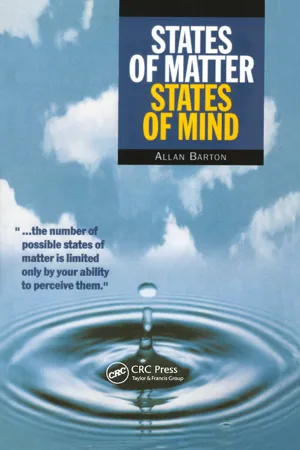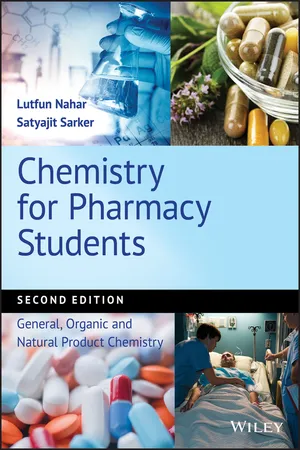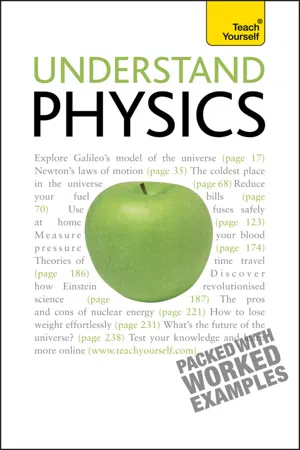Chemistry
Simple Molecules
Simple molecules are composed of a small number of atoms bonded together. They are typically held together by covalent bonds and include familiar substances like water (H2O) and carbon dioxide (CO2). These molecules are fundamental building blocks in chemistry and play essential roles in various chemical reactions and processes.
Written by Perlego with AI-assistance
Related key terms
4 Key excerpts on "Simple Molecules"
- eBook - ePub
Understanding Medicinal Plants
Their Chemistry and Therapeutic Action
- Bryan Hanson(Author)
- 2013(Publication Date)
- Routledge(Publisher)
Chapter 3
The Origins of Bonding and Molecular Properties
In Chapter 2 we explored how to interpret the symbolism of chemical structures. We now will delve into a fuller background for the basis of that symbolism. It is, after all, a symbolism communicating information about real objects—molecules. So, we need to knowhow and why atoms bond together. Then we can consider how the structure of a molecule can tell us about its properties, which in turn will tell us about the molecule’s behavior as a drug. Bonding and molecular properties are thus essential to understanding everything else in this book.ELEMENTS, ATOMS, AND THE PERIODIC TABLE
Atoms of different elements are the fundamental building blocks of all matter, including molecules of medicinal interest, so we should spend some time discussing these building blocks before using them to create molecules.An element is a substance that cannot be separated into simpler substances by a chemical reaction.1 This is a nice textbook definition, although rather impractical in many ways (e.g., how do you know if you have tried all possible chemical reactions?). Perhaps it is better to think of it this way: if something is not an element, it must be a compound, which is a combination of two or more elements. A compound, in contrast to an element, can be broken down further. Examples of elements are the oxygen you are breathing, the carbon in the pencil you use (although it suffers the misnomer “lead,” a different element), and the aluminum in aluminum foil. Applying our definition using aluminum as an example, we would say that a sample of aluminum foil cannot be broken down any further and still be aluminum. On the other hand, water (H2 O) serves as an example of a compound. With the appropriate conditions, we can break water down further, into hydrogen and oxygen gases, which are themselves elements.2 Other simple compounds that most people are familiar with include carbon dioxide (CO2 ) and alcohol (as found in liquor −C2 H6 - eBook - ePub
- Allan F.M. Barton(Author)
- 2021(Publication Date)
- CRC Press(Publisher)
3 .9.2 Molecules
Amedeo Avogadro early in the nineteenth century introduced the term ‘molecule’, meaning a particle composed of atoms, either similar or dissimilar. Because atoms combine in definite numbers in molecules, it follows that chemical elements combine in definite proportions to make compounds, a compound being a pure substance made up of more than one element.Some chemical elements when not combined with other elements exist as free atoms rather than as molecules. There is no generally accepted collective term to describe both molecules (like O2 , oxygen gas, or H2 O, water) and free atoms (like O, oxygen atoms), but we are using ‘molecular particle’ for this purpose. If a molecular particle carries a net electrical charge it is an ‘ion’ rather than a molecule or atom. ‘Cations’ carry positive charges and ‘anions’ carry negative charges.We consider two or more atoms associated for times which are significant on a human scale to have independent existence as a molecule. Now we have our models of atoms, the next step is to visualise the process of combining them into molecules.The matter-wave model which has been so successful in ‘explaining’ the properties of atoms also accounts for chemical bonding and the formation of molecules. Electron waves encompass all nuclei in the molecule, counteracting and balancing the repulsion expected between positive nuclei.9.3 Bond Models
In the particular conditions existing on the Earth the atom is the most convenient building block for our models of matter, but to the early scientists this was not immediately obvious. To start with, pure materials are rare in nature, most occurring as mixtures with other compounds. It is also rare for chemical elements to exist as isolated atoms. Except for the noble gases (such as helium, neon and argon) they usually combine with other atoms at ordinary temperatures, and to liberate free atoms requires considerable expenditure of energy. Even those chemical elements that occur uncombined with other elements tend to have their atoms chemically bonded to atoms of the same kind. The elements oxygen, hydrogen and nitrogen and the halogens (fluorine, chlorine, bromine) often occur as the ‘diatomic’ (two-atom) molecules O2 , H2 , F2 , Cl2 and Br2 . Carbon exists as graphite, diamonds or fullerenes, and gold occurs as a solid metallic crystal. (Mercury is unique as a metal, being almost entirely monatomic in the gas phase4 - eBook - ePub
Chemistry for Pharmacy Students
General, Organic and Natural Product Chemistry
- Lutfun Nahar, Professor Satyajit D. Sarker(Authors)
- 2019(Publication Date)
- Wiley(Publisher)
Section 2.2 ). Of them, 98 elements occur naturally on the earth, and the elements 99–118 have been synthesized in laboratories or nuclear reactors.Compounds are substances formed when atoms of two or more different elements are joined together, for example, NaCl, H2 O, and HCl. Molecules are made up of atoms stuck together. Note that all compounds are molecules, but not all molecules are compounds. For example, molecular hydrogen (H2 ), molecular oxygen (O2 ) and molecular nitrogen (N2 ) are not compounds as they are composed of a single element, whereas a single molecule of H2 O comprises two atoms of H and one atom of O, and is also a compound. Some molecules, such as proteins, contain hundreds or even thousands of atoms that held together in chains, known as macromolecules.Molecular weight is in atomic mass units because it is the mass of one molecule, whereas molar mass is in grams per mole because it is the mass of one mole of molecule. In fact, there is no difference between molecular weight (MW ) and molar mass (MM ), except the units. For example, the MW of H2 O = 18 g; and the mass of one molecule of H2 O = 3.0 × 10−23 g. A mole is simply an Avogadro's number, which is 6.022 × 1023 , regardless of it is H2 O or NaCl or anything else. The term molar mass in chemistry refers to the mass of one mole of molecule. Thus, the molar mass of H2 O = 6.022 × 1023 × 3.0 × 10−23 g mol−1 = 18.0 g mol−1 .2.2 ATOMIC STRUCTURE: ORBITALS AND ELECTRONIC CONFIGURATIONS
The electrons, which belong to the first generation of the lepton particle family, and are generally thought to be elementary particles, because they have no known components or substructure. Note that leptons are the basic building blocks of matter; that is, they are considered as the elementary particles. Electrons are extremely important in organic chemistry. To understand the fundamentals of chemistry, one must understand the location of electrons, as it is the arrangement of the electrons that creates the bonds between the atoms. - eBook - ePub
- Jim Breithaupt(Author)
- 2010(Publication Date)
- Teach Yourself(Publisher)
compound is a pure substance which consists of one type of molecule only. A compound can be broken down into other substances.An element is a pure substance that cannot be broken down into other substances. There are just 92 naturally occurring elements. Further short-lived elements have been discovered in nuclear reactions, but none of these is found naturally.An atom is the smallest part of an element that is characteristic of the element. The atoms of an element are identical to one another and differ from the atoms of any other element. The lightest atom is the hydrogen atom. The heaviest naturally occurring atom is the uranium atom, which is 238 times heavier than the hydrogen atom.A molecule consists of two or more atoms joined together by force bonds. Each type of molecule consists of a fixed number and type of atoms. For example, every carbon dioxide molecule consists of one carbon atom and two oxygen atoms. Its chemical formula is therefore written as CO2 .The idea of atoms was first put forward in Ancient Greece by the philosopher Democritus (470–400 BCE), who considered objects to be made of tiny indivisible and indestructible particles he called atoms. His theory was rejected by Aristotle, in favour of the theory of ‘the elements’, earth, water, air and fire. The atomic theory was established in its modern form in the early nineteenth century by John Dalton (1766–1844). He knew from the work of other scientists that the composition by weight of the elements in a given compound is always the same. He realized that this is because a compound consists of compound atoms or molecules, each molecule being composed of a fixed number of atoms of the elements that the compound can be broken down into. He worked out the relative weight of each type of atom, based on one unit of atomic weight for the hydrogen atom. He drew up a table of atomic weights for all the known elements and used it to explain why elements combine in simple proportions when they form compounds. Dalton’s atomic theory led to the Periodic Table, which is the basis of modern chemistry and which can only be explained using quantum mechanics (see p. 180
Learn about this page
Index pages curate the most relevant extracts from our library of academic textbooks. They’ve been created using an in-house natural language model (NLM), each adding context and meaning to key research topics.



